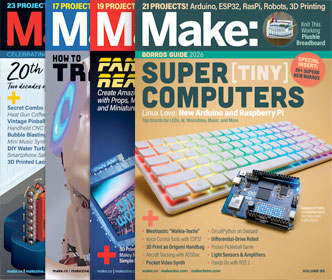
MAKE Flickr Pool member Funax made an Arduino-compatible board powered by a single AAA battery.
A step-up converter is used to boost the battery’s 1.5V output to 5V and meet Arduino’s minimum power requirements. Keep in mind – this circuit would considerably reduce current supplied to the board and therefore limit its ability to power external components.
AAArduino on Flickr- Link
Learn more about DC-DC converters on Jaycar.com – Link
Related:
Uduino – Low cost Arduino development boardLink
Arduino @ MAKE – Link
24 thoughts on “AAA powered Arduino”
Comments are closed.
ADVERTISEMENT
Join Make: Community Today













This looks really cool, kudos to Funax for building such a good looking prototype. But isn’t this Make blog? I want to read about things I can learn to make…not just look at pretty pictures.
I tend to agree nullobject, that is pretty interesting, but as a whole the post is like the original Arduino just linking back to the Atmel datasheet and saying go ahead, build one.
Just out of curiousity since it’s not at all evident, is the chip itself generating the oscillations for the buck regulator?
And for the rest of us, http://www.sparkfun.com/commerce/product_info.php?products_id=8248
Any word on runtime length?
AAA’s are pretty low power batteries, plus you have voltage converter loss.
The converter is around 85% efficient so losses aren’t bad. AAA’s will give you close to an amp-hour at 1.5 volts, the MCU with no LEDs or such draws at most a few mA.
Overall, it is a practical solution. I’d like to get a handful of those boost regulators, I found the company site and datasheets, but none of the usual sources (like mouser and digikey) stock them.
Yup, AAAs put out about 1000 milliamp-hours (mAh). The converter gives 85% efficiency, so effectively 850 mAh. The AVR ATmega168 in an Arduino draws max about 20 mA when active. That means an AAA would let an Arduino last about 850mAh/20mA = 42 hours (at best). Of course, if you drive an LED at max brightness, it also consumes 20mA, so your lifetime goes down to about 21 hours.
Of course, if you were really power conscious, you’d use PWM on the LED and some of the various sleep modes to extend the lifetime to weeks or months.
Todbot,
Your calculations omit voltage. Your capacity is 850mAh at 1.5V. Yet your demand is 20mA at 5V. Doesn’t that mean your calculations are off by a factor of 3?
Yup, you’re right, I spazzed. The “efficiency” of the converter is really power or energy conversion efficiency. Power is in Watts, which is voltage*current. Energy is Watt-hours. The energy available in a AAA is 1.2V * 1000mAh = 1200 mWh. After conversion at 85% efficiency, that’s 1020 mWh. Since the converter is a 5V one, the available current capacity is 1020 mWh / 5V = 204 mAh.
A shortcut to get to that number is to multiply the capacity of the battery times the effiency of the converter times the ratio of the voltage change:
1000 mAh * 0.85 * (1.2V/5V) = 204 mAh
1.2V? Using rechargeables eh?
Long story short you get about 10 hours (+-3 hours depending on battery type) of use. It would work nice as a backup if you’re working off a wall adapter.
hallo,tengkyu
Hi,
actual current at Vin of converter is 85mA (2 LEDs are active, 16MHz external xtal). I think the efficiency is
Hi,
Can i get the schematic one ?. It’s very interesting, and i want to build some…
Thanks..
GPRS and EGDE, both of which are class 10 are provided as
are blue tooth and mini – USB. 0 is provided and offers excellent means of navigation around the functionality.
Other connectivity options are available too, including a trio of
USB 2. This is an Acer Laptop Review on the Acer AS1430Z-4677 which features a lightweight design at just a little over 3 pounds with excellent performance.